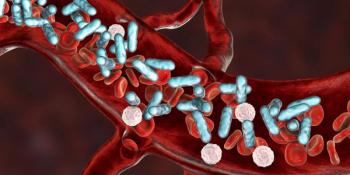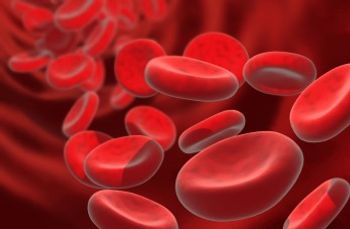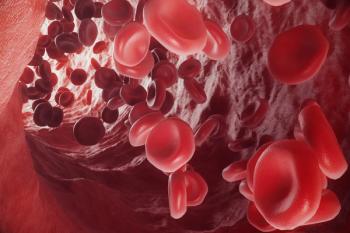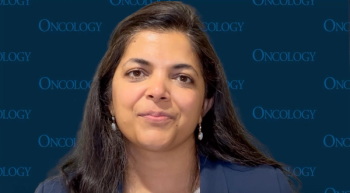
Oncology NEWS International
- Oncology NEWS International Vol 12 No 8
- Volume 12
- Issue 8
Recently Released Data Show Benefits of FOLFOX4 Extend to Adjuvant Setting
This special supplement to Oncology News International includes 28 reportswith updated information on clinical trials investigating capecitabine and other agents inthe treatment of advanced colorectal and breast cancers, and other solid tumors.The reports summarize selected presentations from the 39th Annual Meeting of theAmerican Society of Clinical Oncology (ASCO) and related educational symposiaheld in conjunction with ASCO.
PARIS-An international studythat previously demonstrated FOLFOX4to be active and safe in first-line treatmentof advanced colorectal cancer, now showsthat FOLFOX4 increased 3-year diseasefreesurvival and reduced risk of recurrenceby 23% in the adjuvant setting. Aimeryde Gramont, MD, of Hopital SaintAntoine, Paris, reported results on thefirst-line treatment at last year's AmericanSociety of Clinical Oncology meeting(ASCO 2002 abstract 525) and the recentlyreleased data on adjuvant treatment atthis year's meeting (ASCO abstract 1015).MOSAIC StudyUntil the late 1980s there was no adjuvantchemotherapy for colorectal cancer,Dr. de Gramont noted. Then an intergroupstudy established fluorouracil(5-FU)/levamisole as an adjuvant treatment.A few years later, 5-FU/leucovorinbecame the new standard and remainedso for almost 10 years. "The just completedMOSAIC (Multicenter InternationalStudy of Oxaliplatin/5FU-LV in the AdjuvantTreatment of Colon Cancer) studycompared LV/5-FU2 to FOLFOX4 for 6months or 12 cycles. LV/5-FU2 is a combinationof high-dose leucovorin followedby 5-FU as a bolus and a low-dose 22 hourinfusion of 5-FU for 2 consecutive days; itis a semi-monthly regimen. FOLFOX4 isLV/5-FU2 plus oxaliplatin (Eloxatin). Theprimary end point of the study was disease-free survival. Secondary end pointswere safety and overall survival," Dr. deGramont explained.Eligibility requirements were goodperformance status, age between 18 and70 years old, no prior treatment, and eligibility for treatment of stage 2 or stage 3colon cancer after compete resection ofthe tumor.Followed Every 6 MonthsPatients were followed every 6 monthswith clinical examination and imaging.Diagnosis was made on imaging confirmedby computed tomography (CT)scan. Biopsy was required in cases of ascitesor anastomotic recurrence.Included in the study were 2,246 patients,exactly the same number of patientsin each arm. Mean age was 61 or 60years. Main patient characteristics werewell balanced between both arms. Furthermore,the statistical hypotheses wereexactly fulfilled with the percentage ofstage 2 being 40%, and stage 3 at 60%.Patients received a mean of 10.7 cyclesin the FOLFOX4 arm and 11.3 in the LV/5-FU2 arm. Seventy-five percent of patientsreceived all the cycles of FOLFOX4.Median dose intensity for oxaliplatin was81% in the LV/5-FU2 arm and 85% in theFOLFOX arm.Survival and RecurrenceWith a little more than 3 years medianfollow-up, 234 events occurred in theFOLFOX arm and 288 in the LV/5-FU2arm. The 3-year survival was 72.9% forLV/5-FU2 and 77.8% for FOLFOX. Thedifference was highly significant, with ahazard ratio of 0.77.There was a 23% reduction in risk ofrecurrence. For stage III disease, 3-yeardisease-free survival with FOLFOX was71.8% and 65.5% for LV/5-FU2. The hazard ratio was 0.76 with a 24% reduction inthe risk of recurrence. For stage II disease,the 3-year disease-free survival was 86.6%for FOLFOX4 and 83.9% for LV/5-FU2.The hazard ratio was 0.82 with an 18%reduction in the risk of recurrence.FOLFOX4 improved the prognosis inall subsets of patients including, gender,age, number of lymph nodes, obstruction,perforation, carcinoembryonic antigen(CEA), and differentiation.No Mortality IncreaseAs noted in safety data presented lastyear, FOLFOX did not increase mortalityduring the treatment compared to LV/5-FU2 alone. It did not increase the number of vascular events. The most frequentgrade 3/4 toxicity was neutropenia, whichoccurred in 41% of patients. Febrile neutropeniaand sepsis occurred in less than2% of patients. Gastrointestinal toxicitywas moderate and less than 11% of patientshad diarrhea.During treatment, grade 3 sensory neuropathy,involving some functional impairment,occurred in 12.4% of the patients.One year after completion oftreatment with FOLFOX4, only 1% ofpatients still had grade 3 sensory neuropathy.An additional 4% of patients hadgrade 2 and 24% had grade 1 sensoryneuropathy.Dr. de Gramont concluded by stating:"FOLFOX4 is a safe regimen in the adjuvanttreatment of colorectal cancer. It doesnot increase mortality. Less than 2% ofpatients had febrile neutropenia, and therewas a limited GI toxicity and alopecia.Grade 3 neuropathy occurred in 12% ofpatients, but only 1% of these were atgrade 3 at 1 year. For the primary endpoint, 3-year disease-free survival,FOLFOX4 is the first regimen to prove tobe superior to leucovorin and 5-FU in theadjuvant treatment of colorectal cancer.There also was a reduction of 23% in riskof recurrence. And the benefit ofFOLFOX4 was observed in all subsets ofpatients."
Articles in this issue
over 22 years ago
VEGF-Expressing TAMs Linked to Improved Colon Ca Survivalover 22 years ago
Bexxar Approved for Relapsed/Refractory NHLNewsletter
Stay up to date on recent advances in the multidisciplinary approach to cancer.

















































































